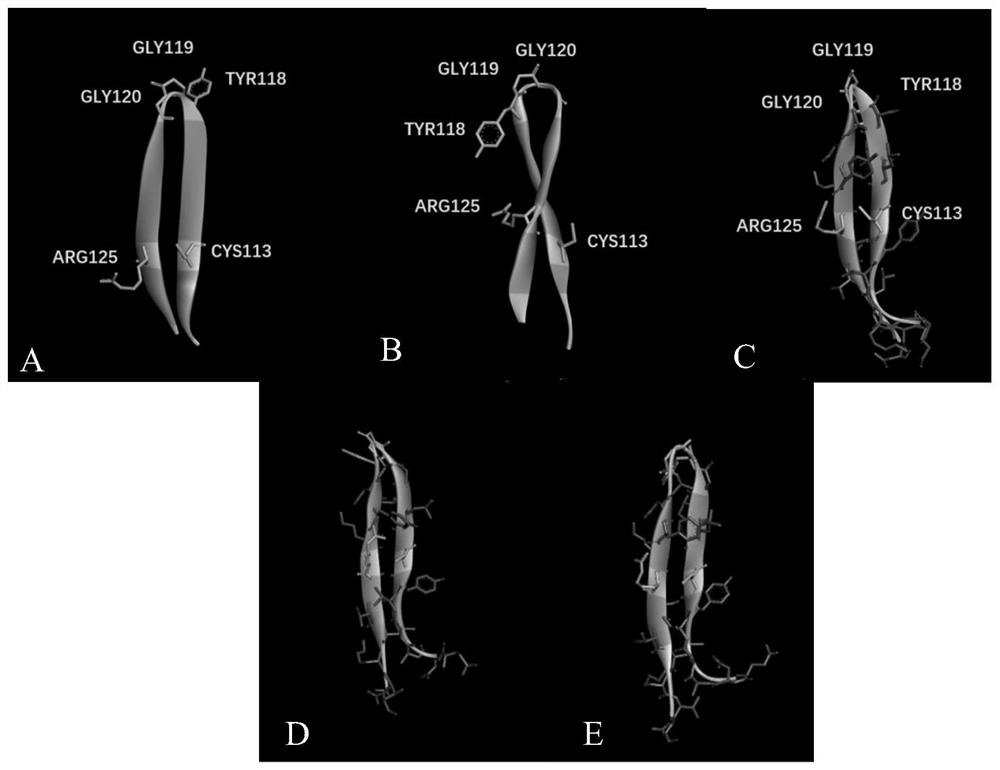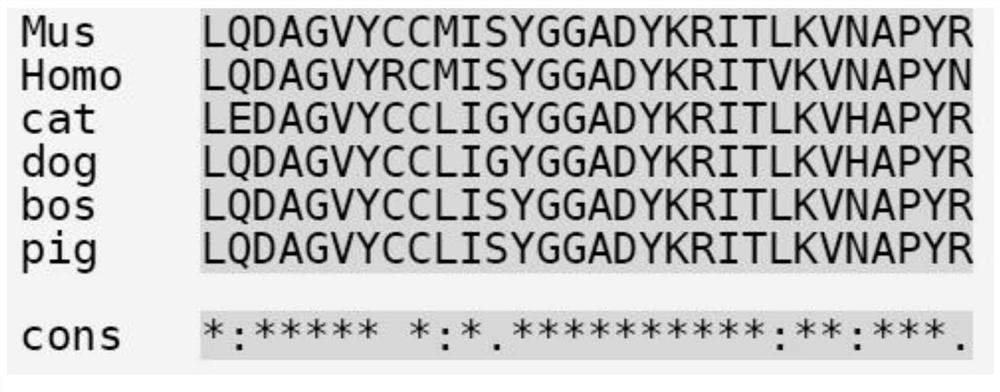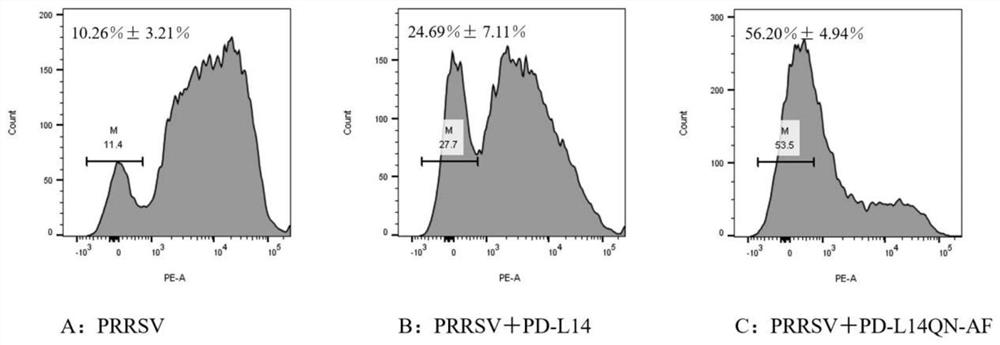Pig PD-L14QN-AF epitope polypeptide and application thereof
A PD-L14QN-AF, PD-L14QN-F technology, applied in the field of animal molecular immunology, can solve the problems of small toxic and side effects, high price, adverse reactions, etc.
- Summary
- Abstract
- Description
- Claims
- Application Information
AI Technical Summary
Problems solved by technology
Method used
Image
Examples
Embodiment 1
[0037] Example 1 Screening and Length Optimization of Polypeptide PD-L14
[0038] Screening of the polypeptide PD-L14: According to the reconstructed porcine PD-1 / PD-L1 complex structure and the analysis results of the action surface, the original space structure of the polypeptide was analyzed, and the polypeptide PD-L14 was screened. The sequence of the polypeptide PD-L14 is located in the FG loop region of the porcine PD-L1 protein, starting from the 106th amino acid Ala to the 126th amino acid Lys, covering a complete loop region and including hotspot amino acids Ala121, Asp122, Tyr123 and Arg125, the amino acid sequence is: AQINECLISYGGASYPRITLK (SEQ ID NO: 1).
[0039] Optimization of the polypeptide PD-L14: According to the protein interaction surface analysis, the fragment of the polypeptide PD-L14 forms a hairpin secondary structure, and Tyr118, Gly119, Gly120, Lys131, and Ala121 form a β-turn, and the center of the turning point is located at Gly119. Taking Gly119 a...
Embodiment 2
[0041] Embodiment 2 Amino acid residue mutation method of polypeptide PD-L14
[0042] PD-1 and PD-L1 are expressed in multiple species. In this experiment, the amino acids of some representative species were selected for sequence comparison. They are derived from humans (Homo sapiens), pigs (Sus scrofa), cattle (Bos taurus), mice (Mus musculus), domestic cats (Felis catus), dogs (Canis lupus familiaris), and are helpful for us to understand pig PD. The research on the structure, function, properties and homology of PD-1 and PD-L1 provides ideas for the optimization of peptide design. Expresso is a unique comparison tool for proteins under the T-Coffee website. Using Expresso to perform multiple sequence alignment of 6 PD-L1 protein sequences, the results are as follows figure 2 shown.
[0043] The analysis shows that the benzene ring of Tyr123 of porcine PD-L1 protein is embedded in the groove of the hydrophobic active center of PD-1 protein, and forms a π-π conjugate with...
Embodiment 3
[0047] Embodiment 3 Fluorescence quantitative PCR detects the establishment of PRRSV method
[0048] (1) Infection of porcine PBMCs with PPRSV in vitro
[0049] Separation of PBMC from porcine peripheral blood: extract 4mL of blood from the anterior vena cava of healthy pigs, add sodium citrate anticoagulant, the ratio of whole blood to anticoagulant is 10:1, gently mix up and down, add PBS solution at a ratio of 1:1 Dilute whole blood. Add the same volume of lymphocyte separation medium into a sterile centrifuge tube, tilt the centrifuge tube, and use a sterile disposable plastic test tube to gently spread the diluted pig blood along the tube wall above the liquid surface of the separation medium. Use a horizontal centrifuge to centrifuge at a speed of 500-1000g for about 20-30min. Note that the speed of centrifugation should not exceed 1200g. Gently take out the centrifuge tube, and observe that there is a thin buffy coat layer between the plasma layer and the separation l...
PUM
| Property | Measurement | Unit |
|---|---|---|
| Titer | aaaaa | aaaaa |
Abstract
Description
Claims
Application Information
 Login to View More
Login to View More - R&D
- Intellectual Property
- Life Sciences
- Materials
- Tech Scout
- Unparalleled Data Quality
- Higher Quality Content
- 60% Fewer Hallucinations
Browse by: Latest US Patents, China's latest patents, Technical Efficacy Thesaurus, Application Domain, Technology Topic, Popular Technical Reports.
© 2025 PatSnap. All rights reserved.Legal|Privacy policy|Modern Slavery Act Transparency Statement|Sitemap|About US| Contact US: help@patsnap.com



